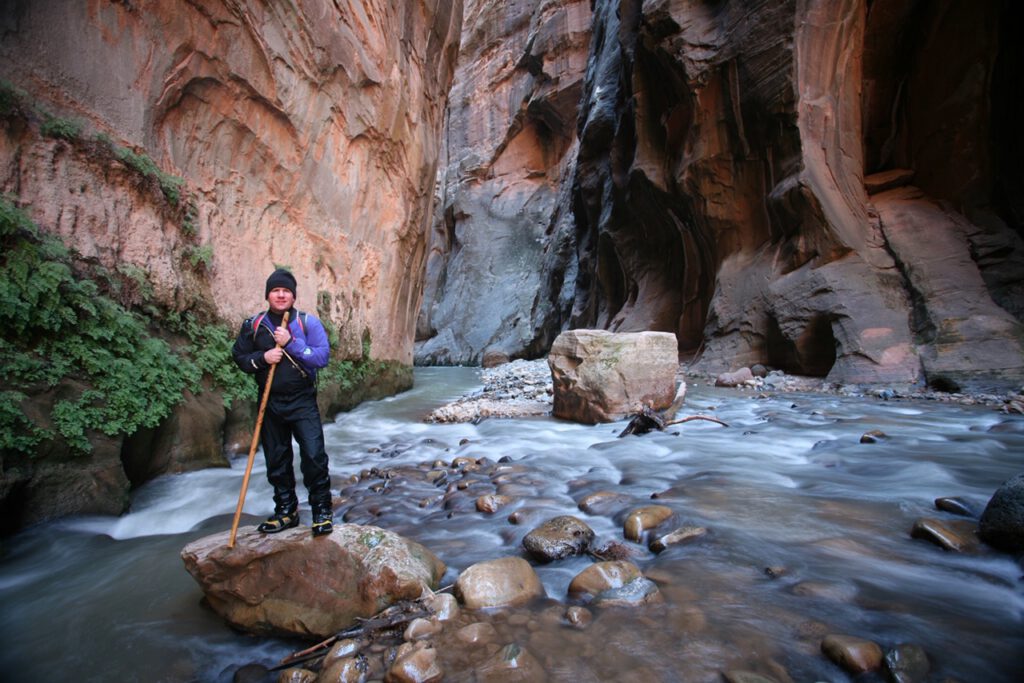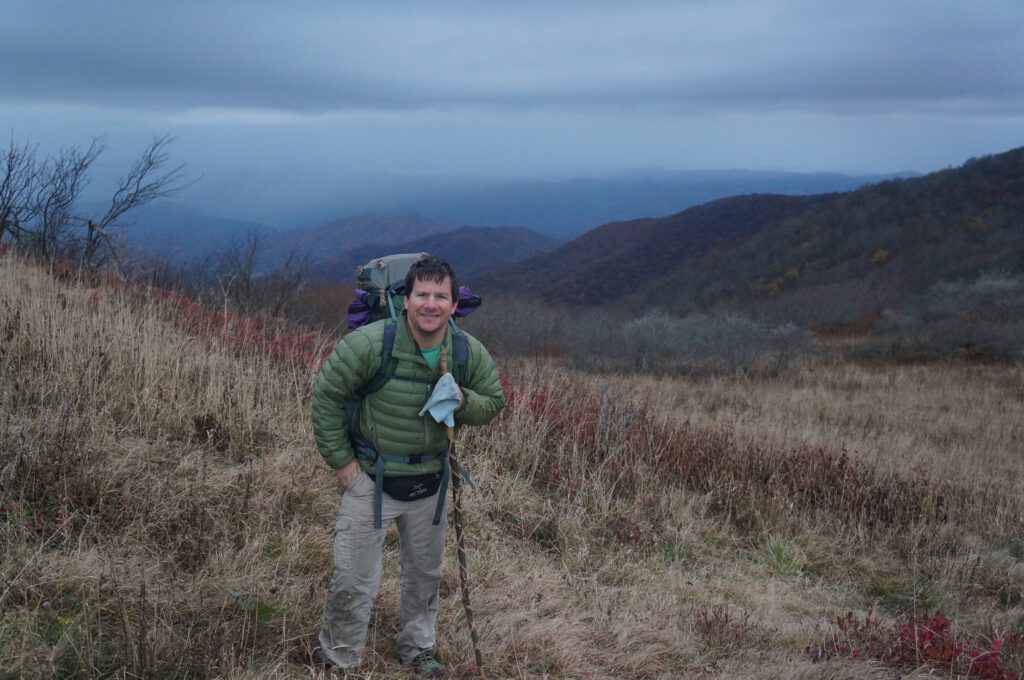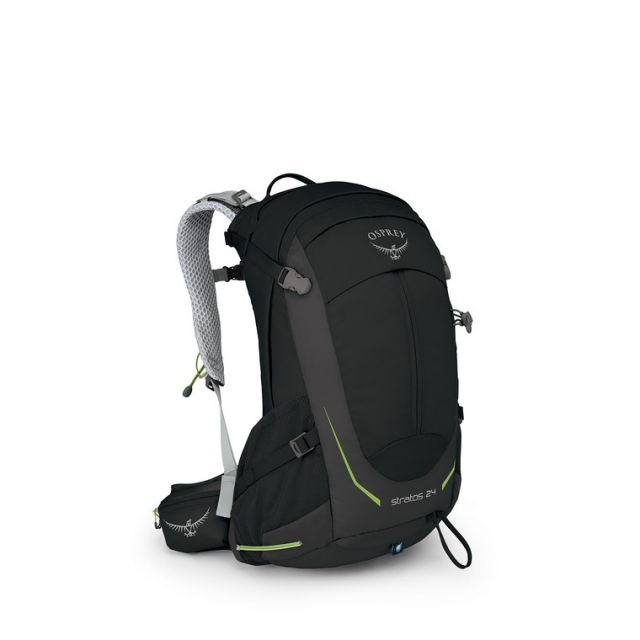
Rudy Hayden, captain of our Charlotte store, knows a thing or two about being uncomfortable in the wild.
“We did a bike tour up in the Davidson River area of the Pisgah a couple years ago that was cold, it was windy, there was rain there was snow,” he recalls with a laugh explained only by the passage of time. “We rode out of the fish hatchery, and on the second night the three of us slept under a tarp. The rain, the wind — man, it was a long night. We were trying to go light, but it was brutal.”
So when you walk in his store and ask Rudy to recommend a shelter on a winter backcountry trip, he will not suggest that you use a tarp. Rather, he might start by asking whether you’ll be sharing the tent with a friend, which he recommends both for moral support and to help warm the tent. He will also tell you, from personal experience, that it’s a much better way to stay dry. Then, he might steer you in the direction of one of the tents in his arsenal: the MSR Hubba Hubba (when it’s just him, or maybe him and a friend), the MSR Mutha Hubba (when he’s with his boys, ages 6 and 8), or his Nemo Wagontop (when it’s the whole family). Rudy knows what it’s like to spend the night cold and wet: he recommends these tents because he doesn’t want you to know.
Sleep well
Likewise, Rudy knows what it’s like not to get a good night’s sleep camping. In his youth, it didn’t matter what he slept on — he could sleep anywhere. “But as I got older … ” he recognized the importance of a comfy sleeping pad, which is why he now recommends the Sea to Summit Comfort Light Insulated Mat, which is 2.5 inches thick, sufficient to keep you from touching ground, and with its Air Sprung Cell technology — a double layer of high resolution cells in the torso for maximum comfort and insulation — helps keep you warm and cozy (it has an R-Value of 4.2). For those days when you’re eager to get up and hit the trail, Rudy says you’ll also appreciate how quickly it deflates. And should you mention that you hope the comfort of the Comfort Light helps offset the iffiness of your stuff-sack-stuffed-with-dirty-clothes pillow, he will likely take you gently by the arm and guide you to the Sea to Summit Aeros Pillow. “It’s a highly packable down pillow, and the material is really comfortable.” More like sleeping at home than crashing in a friend’s dorm room.

Rudy’s layering system
If you’re curious about staying warm on the trail, Rudy likely will suggest his personal layering system. Building from inside out, he goes with:
Base layer: Smartwool 250 Merino long-sleeve shirt. No question there, for comfort, dryness, warmth.
Second layer: Patagonia R1. A workhorse winter top for dealing comfortably with cold temps. Zip-up neck, zip-up chest pocket, a close, efficient fit.
Third layer (if necessary): “Well, I still have an old Layers windproof vest,” says Rudy, referring to Great Outdoor Provisions personal line of gear from the 1990s, “but today I would recommend the Arc’Teryx Atom SL Vest. It does a great job of keeping your core warm, while breathing to keep you from building up sweat.”
Fourth layer (when necessary): And when it’s especially cold or he takes a break on a long winter hike, Rudy will throw on his Arc’Teryx Cerium Hoody. It’s down, it’s warm, it has a good warmth-to-weight ratio.
Backpacking light (but not ultra-ly so)
Rudy goes with light basic gear — his pack, tent and sleeping bag combined weigh less than 7 pounds — but he doesn’t consider himself an ultralight backpacker. “I need gear that’s durable, that I don’t have to worry about, but that isn’t real heavy.” Going light in some areas allows him to go heavier in others. “I carry a lot of photo gear when I backpack, and I like to carry certain extras — first aid supplies, batteries — in case someone else needs them.”
He also indulges the occasional luxury. Like a backpacking camp chair.

“My favorite right now is the Big Agnes Skyline UL Chair,” says Rudy. “It’s a little lighter than some of the other chairs and it sits a little higher. And it’s nice to have a place to sit after a day on the trail.”
Favorite new piece of gear: “The Soto WindMaster stove. It needs no priming, can run on white gas or isobutane, it simmers. I’ve had it about a year and it’s great.”
Most versatile piece of gear: “My Buff. Gosh, you can do everything with it. You can use it for first aid, use it as a towel to clean up messes, if it’s dusty you can use it to cover your mouth, if it’s cold put it on your head.”

Go-to day pack: “I always keep my Osprey Stratos 34 in the car. For day hikes, for weekend travel … . The back breathes well and it’s the perfect size. It’s also got the right number of pockets; too many pockets and you can’t remember where you put things.”
Go-to travel pack: For longer trips where packing a carryon and traveling light is essential, Rudy is wed to his Osprey Porter 46. Seriously, he’s been with his Osprey Porter longer than he’s been with wife Sarah: 15 years. Together (Rudy and his Osprey Porter) have traveled to Peru several times on mission work, to Costa Rica and to other far-off destinations. “After 15 years,” he says with affection, “it still looks brand new.”
Rudy and his Osprey Porter: isn’t that the kind of long-term relationship we all seek with our gear?
